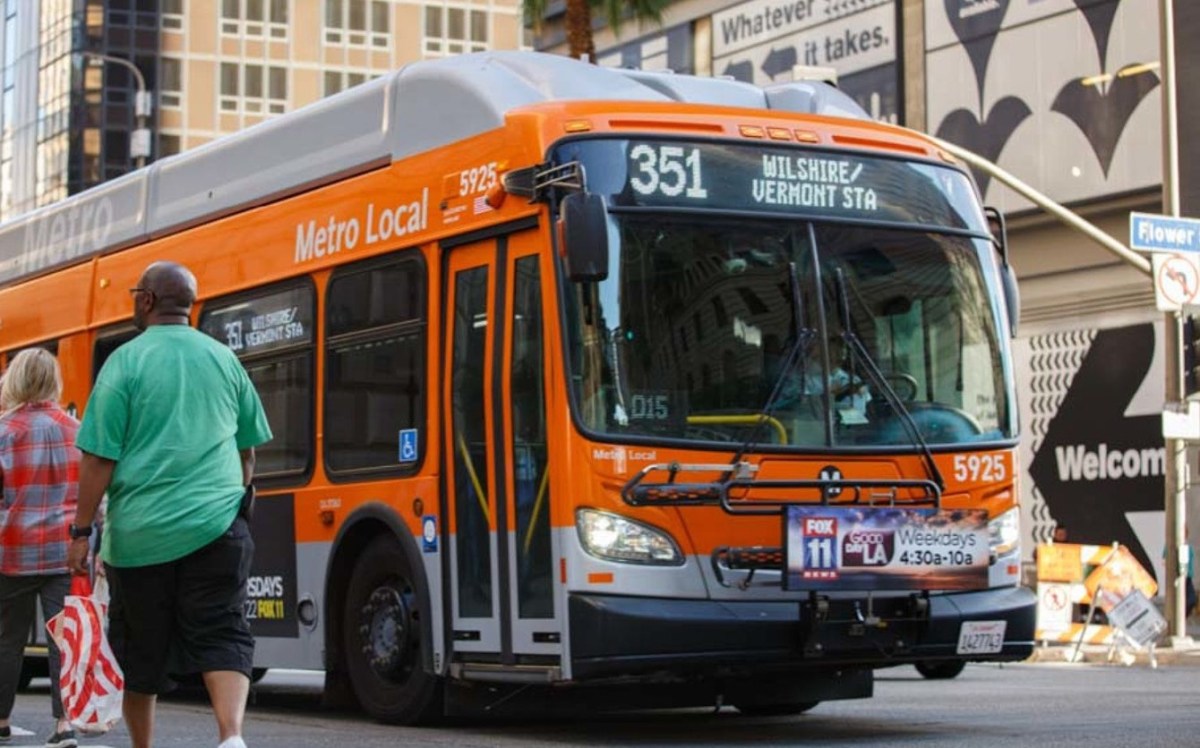
Last spring, the onset of COVID-19 roiled transit agencies. Falling revenues posed an existential threat to many. Thousands of transit workers fell ill or were forced to quarantine, and more than a hundred lost their lives.
For transit riders, the pandemic brought about sudden and severe cutbacks in service. Nearly all transit agencies have restored some service since then, but a TransitCenter analysis shows wide variation.
Of the 150 largest transit agencies, about one in six were providing less than 75% of their pre-pandemic service hours in December 2020. Meanwhile, nearly a quarter were running between 90 and 100% of pre-pandemic service, and 27 agencies were running more service than they were before the pandemic as part of providing socially distanced transit.

Our analysis looks at fixed-route transit service (not vanpools, paratransit, or on-demand service). It’s based on National Transit Database monthly data, which are preliminary and often adjusted 2-5% in later months.
Big differences exist among some of the largest agencies. Most struggled with labor shortages early in the pandemic, running less than 80% of pre-pandemic service in May, with service rebounding in the summer, fall, and winter. Others didn’t increase service to the same extent, citing the need to hold funding in reserve to mitigate future deficits, or in response to lower ridership. (SFMTA has also faced technical challenges restoring Muni Metro service.)
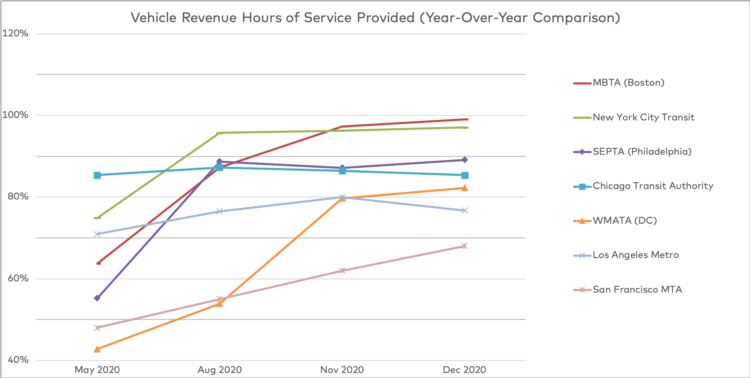
Differences also exist among medium-sized agencies. Phoenix’s part of the Valley Metro regional transit system was actually operating more service than it did before the pandemic. Meanwhile, transit agencies in Dallas and St. Louis were operating below 85% of pre-pandemic service.
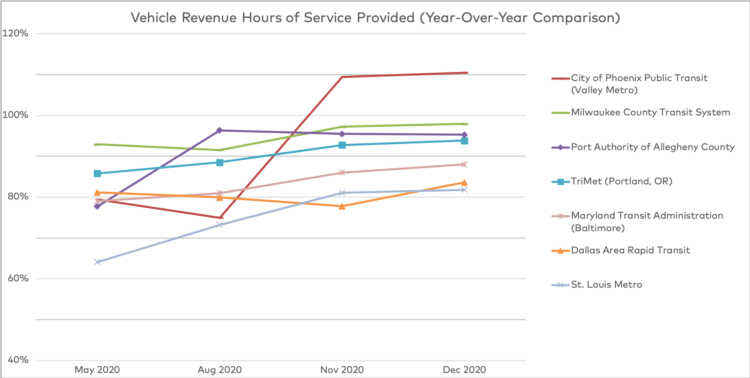
Commuter rail agencies are among those that have cut back service the most, perhaps understandable given that their ridership is weighted toward high-income office commuters, many of whom have sharply reduced transit use as employers have instituted work-from-home policies.
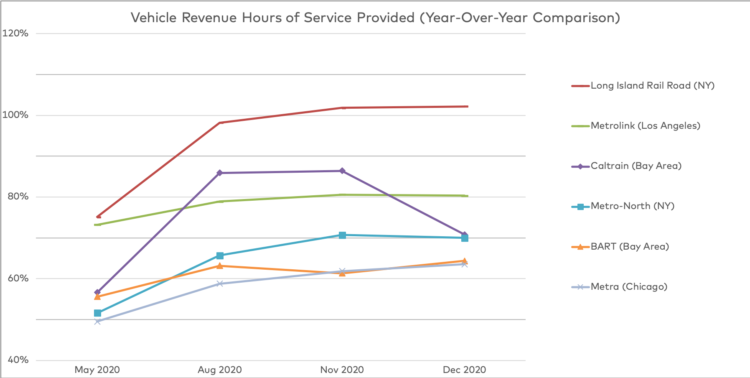
Yet the cutbacks also represent a missed opportunity to reorient toward providing affordable, convenient service for riders who have traditionally been excluded from commuter rail due to price and schedule. Some agencies have remade their service in limited ways. Metra is offering half-price fares on two lines running through communities of color on Chicago’s South Side and South Suburbs. Boston’s MBTA has begun a similar program on its Fairmount Line. New York’s LIRR, one of the few commuter rail agencies to maintain service levels, has been providing overnight service at a discounted price at a time when NYC’s subway has been shut down.
(Note: BART does not use commuter rail technology but shares some characteristics of the mode, like high fares and long distances between stations in its outer service area; it benchmarks itself against international suburban railways as well as metro systems.)
Should Agencies be Required to Run Service?
Maintaining service matters for several reasons. Millions of essential workers and households without cars continue to ride transit — they lose time and money when service is cut. And as vaccination accelerates, case rates decline, and greater activity resumes in cities, the transit network must be ready to carry more trips. The path out of the emergency for transit agencies depends on providing a service that people want to ride — cutting bus operators and letting service decline now will have long-lasting effects that impede recovery later.
However, simply counting service hours is not a full measure of how an agency is responding to the pandemic. Where and how service is deployed matters too. While the San Francisco MTA is running significantly less service than before the pandemic, it redesigned its network to focus frequent service in low-income areas and communities of color.
It may not be possible to immediately increase service in every region, especially where there’s a shortage of trained operators. Some agencies are also dealing with local and state governments that have used federal aid as a cover to clawback transit funding.
But the overall situation shows that most agencies have been able to provide more than 80% of pre-COVID service in order to maintain safe, reliable mobility for everyone who needs to travel. For the relatively few agencies that aren’t doing this, the argument for doing so becomes even more pronounced if new federal support arrives. “Saving for a rainy day” is a hard argument to make in the midst of the hardest storm to hit transit riders in a generation.
Could the federal government require agencies to run more service as a condition of relief? Recipients of earlier rounds of federal relief funding have been told that the money must, “to the maximum extent possible, be directed to payroll and operations of public transit … unless the recipient certifies to [the Federal Transit Administration] that the recipient has not furloughed any employees.” This could theoretically be strengthened to include a minimum service requirement.
The more likely scenario is that it will be up to local officials and advocates to keep service running. Los Angeles advocates recently convinced LA Metro’s board to direct the agency to restore pre-pandemic service levels. In Boston, criticism of service cuts helped pressure the MBTA to restore late-night rail service.
Notes
The analyses above rely on the National Transit Database Monthly Adjusted dataset, accessed in February 2021 and showing reports through December 2020. We omitted demand-response and vanpool service (“DR” and “VP” modes in the NTD).
Both the Maryland MTA and San Francisco MTA’s December 2020 submissions to NTD undercounted service hours for several months. (In Maryland MTA’s case, this was due to a methodological error in measuring rail service hours; in SFMTA’s case it was due to a clerical error in compiling the December report.) In this post, we cite corrected statistics sent to us by both agencies. The corrected figures omit commuter rail, commuter bus, cable car, and streetcar service hours.
We defined “the 150 largest transit agencies” as the 150 agencies which ran the most vehicle revenue hours in December 2019.
 New TransitCenter Report: To Solve Workforce Challenges Once and For All, Transit Agencies Must Put People First
New TransitCenter Report: To Solve Workforce Challenges Once and For All, Transit Agencies Must Put People First
TransitCenter’s new report, “People First” examines the current challenges facing public sector human resources that limit hiring and retention, and outlines potential solutions to rethink this critical agency function.
Read More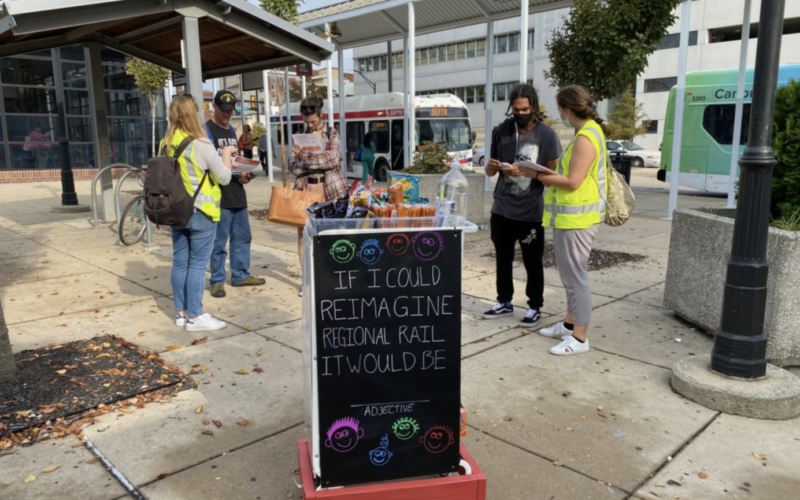 A Transit Revolution in Philadelphia?
A Transit Revolution in Philadelphia?
The Southeastern Pennsylvania Transportation Authority (SEPTA) has been working throughout the pandemic on several system-wide planning initiatives that have the potential to transform transit service in and around the city of Philadelphia.
Read More